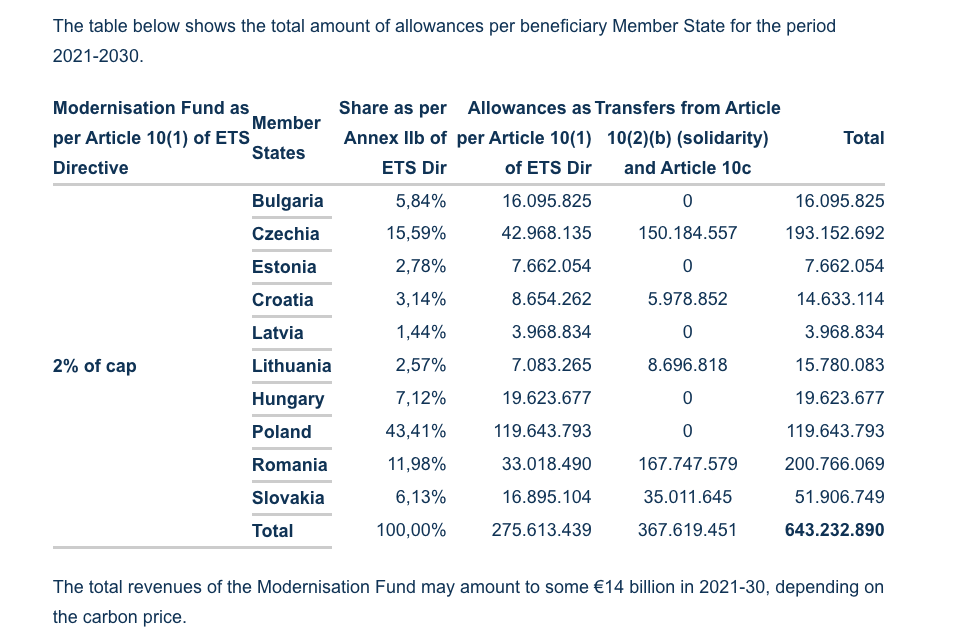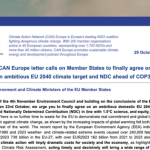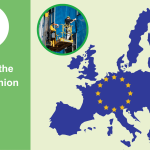POLICY BRIEFING

The Modernisation Fund is recognised in the European Green Deal Investment Plan as one of the key funding instruments, potentially providing around €25 billion to support Member States in their transition to a climate-neutral society. The Fund will start supporting projects as of 2021. There are many loopholes in its current set-up which can cause a continued lock-in into fossil fuels in the Beneficiary Member States. It is likely that the European Commission will also suggest changes to the Modernisation Fund as part of their legislative proposal for the revision of the Emissions Trading Directive (ETS). Several Member States have been actively calling for an increase of the Fund. This briefing aims to set out a number of principles and demands to ensure that:
-
Projects that will benefit from the Fund focus on renewable energy and energy efficiency investments which are compatible with the climate neutrality, zero pollution, and just transition objectives of the European Green Deal, and do not cause a lock-in into fossil fuels;
-
The revision of the Modernisation Fund does not provide support for fossil fuels, but becomes a driver for the just transition of our economy based on a highly efficient and 100% sustainable renewable energy system, and does not go against the objectives of the European Green Deal and the EU’s commitments under the Paris Agreement.
BACKGROUND
In December 2020, the European Council agreed on increasing the EU’s 2030 climate target to at least 55% net emission reductions and gave the political green light to the European Commission for presenting a broad package of legislative proposals and revisions to key EU climate and energy policies in June 2021, the so-called “Fit For 55” package.
Achieving a higher level of climate ambition will require substantial additional investment, both private and public. The European Commission, in its impact assessment on the 2030 climate target estimates that policy scenarios in line with the at least 55% target will increase additional investment needs to between EUR 65 billion and EUR 102 billion per year. Hence, the discussion about implementing the new level of climate ambition is closely linked to the search for additional funding sources and the question of how the EU’s financial resources should be spent over the coming years.
One source of particular interest in Central and Eastern European Member States is the Modernisation Fund, a new financing tool created under the EU Emissions Trading System (ETS) during its revision in 2018. The Fund will start supporting projects in Phase 4 of the EU ETS, meaning between 2021-2030. Currently, Member States are selecting priority and non-priority investment projects to be supported by the Fund. Once approved by the European Investment Bank and the European Commission, these investment projects will be the first ones to benefit from the Modernisation Fund. The selection and assessment processes, including criteria, are very important as the investment decisions made today will determine the European economy’s progress on the pathway to climate neutrality and will have a direct impact on the communities to benefit from these investments.
It is likely that the European Commission will also suggest changes to this Fund as part of their legislative proposals for the revision of the ETS Directive. Several Member States, particularly Poland, have been quite active in calling for an increase in these financial resources dedicated to supporting the transition in Central and Eastern European Member States, raising their specific demands for a revamp of the Modernisation Fund over the past weeks and months.
In December, the European Council conclusions also picked up on these demands: “The problem of imbalances for beneficiaries of the Modernisation Fund is not receiving revenues that are equivalent to the costs paid by the ETS installations in those Member States will be addressed as part of the upcoming legislation”.
MODERNISATION FUND – THE CURRENT SETUP
The Modernisation Fund has been established through Article 10d of the EU ETS Directive and is accessible for 10 lower-income Member States with a GDP per capita at market prices below 60% of the EU average in 2013. These eligible Member States are Bulgaria, Croatia, Czech Republic, Estonia, Hungary, Latvia, Lithuania, Poland, Romania, Slovakia.
The objective of the Fund is to support investments proposed by the beneficiary Member States, including the financing of small-scale investment projects, to modernise energy systems and improve energy efficiency.
The Modernisation Fund is funded from the revenues generated by 2% of auctioned emission allowances for the period 2021-2030, and additional allowances transferred[4] to the Modernisation Fund by beneficiary Member States – see overview below. The Fund is also recognised in the European Green Deal Investment Plan as one of the key funding instruments, to provide some €25 billion – total amount depending on the expected carbon price revenues – for the EU transition to climate neutrality.

The table shows the share of total allowances each Beneficiary Member State receives from the Modernisation Fund under its current set up in the period 2021-2030. The total amount of allowances set aside for the Modernisation Fund (643 million) consists of two building blocks: i) allowances representing 2% of the cap totaling 275.6 million allowances which are divided according to the percentage shares stated in Annex IIb of the ETS Directive (the respective amount of allowances as per Article 10(1) of the ETS Directive in the central column of the table), ii) transferred additional allowances totaling 367.6 million allowances which can come from two sources: Either they are part of the solidarity transfers of auctioned allowances representing 10% of auctioned allowances according to Article 10 (2)(b) of the ETS Directive[This is the case for Czechia (38.7 million allowances), Romania (81.6 million allowances) and Slovakia (1.7 million allowances)]. Another source of additional allowances is Article 10c which grants lower income Member States transitional free allowances for the modernisation of their energy sector[Additional allowances from Article 10c were transferred by Czechia (11.5 million allowances), Croatia (6 million allowances), Lithuania (8.7 million allowances), Romania (86.1 million allowances) and Bulgaria (33.2 million allowances).]. Five Member States (Czechia, Croatia, Lithuania, Romania and Bulgaria) have chosen to transfer additional allowances.
Eligibility criteria are set out in Article 10d, paragraphs 1 and 2. No support for solid fossil fuels (coal) is allowed, with the exception of “efficient and sustainable district heating” in Bulgaria and Romania.
In the current funding programme, at least 70 % of the financial resources from the Fund shall be used to support ‘priority investments’ in renewables, energy efficiency, energy storage and the modernisation of energy networks, including district heating networks, grids for electricity transmission and interconnections. Investments in energy efficiency in transport, buildings, agriculture, and waste can also be eligible. The Fund can be used to support just transition, additionally to the Just Transition Mechanism, in funding redeployment, re-skilling and up-skilling of workers, education, job-seeking initiatives, and start-ups, in dialogue with the social partners.
This means that currently, up to 30% of the Modernisation Fund could still be used for ‘non-priority investments’ meaning non-solid fossil fuels such as gas or oil shale.
The current framework fails to ensure consistency of the eligible investments in the Modernisation Fund with the EU’s climate neutrality target and engagements under the Paris Agreement, as a requirement.
Download the full Policy briefing below
LOOPHOLES IN THE CURRENT FUND RISK A LOCK-IN TO FOSSIL FUELS
ONGOING INVESTMENT PLANS BEHIND CLOSED DOORS
DISCUSSIONS ABOUT CHANGES TO MEDERNISAITON FUND AND THE NEED FOR STRICTER ELIGIBILITY CRITERIA
POLICY RECOMMENDATIONS
In order to ensure that the EU Modernisation Fund fully contributes, and does not contradict the EU’s new 2030 climate and environmental ambitions and its long term objectives, we put forward the following recommendations:
-
Beneficiary Member States must not select any fossil fuel investment projects to be assessed for eligibility under the Modernisation Fund;
-
Transparency in the selection and the assessment of the eligible projects must be ensured, as well as effective participation and consultation of interested stakeholders at national, regional and/or the EU level;
-
The European Commission should publish additional technical guidance for the selection and the approval of the first roll-out of priority and non-priority investment projects eligible for the Modernisation Fund – in light of the EU’s 2030 climate and environmental objectives;
-
The upcoming revision of the EU Emissions Trading System (ETS) should ensure that no ETS funding programme, nor revenue generated at the EU and national level is used to support fossil fuels as this would be in stark contradiction to the EU’s commitments under the Paris Agreement and its 2030 and 2050 climate and environmental goals;
-
The European Commission should ensure that a review of the Modernisation Fund’s consistency with the EU’s 2030 and 2050 climate and environmental objectives are included in the impact assessment of the ETS revision, and provide further guidance on how to improve the eligibility criteria for coherence. This will help Modernisation Fund criteria be strengthened in the revised ETS, and prevent any support to fossil fuels, securing that all investments to the energy sector contribute to much reduced energy consumption and to provide 100% of all energy from sustainable renewable sources, and just transitions;
-
The energy efficiency first principle should apply. The reduction of energy demand is key for achieving Europe’s climate and energy goals. To this end, investments in energy efficiency measures such as building renovations should be a priority. This will facilitate the efforts to phase out fossil fuels and shift to a fully renewable-based energy system, helping the EU fulfil its commitments under the Paris Agreement;
-
Funding should support renewable energy projects as well as projects that allow for faster integration of its increasing supply. This implies a cross-sectoral optimisation of infrastructure planning and operation. Demand and supply in the electricity sector need to interact closely with demand and supply of heat, gas or with mobility needs, e.g. through grids and storage;
-
The European Commission should consider including a provision for technical assistance to municipalities to develop projects under the Modernisation Fund, in line with just transition plans and updated guidance on eligible projects. This will increase the strategic nature of spending to the implementation of just transitions and ensure that projects financed respond to the needs of communities;
-
The European Investment Bank (EIB) should be consistent with its commitment to stop lending money for fossil fuel projects, especially now to signal alignment with the Paris Agreement, as the EU Climate Bank. The assessment of the non-priority investment projects should be guided by the EIB’s energy lending policy, which foresees the phase-out of unabated fossil fuel energy projects – including fossil gas.
REFERENCES
4] Five Member States, Croatia, Czechia, Lithuania, Romania and Slovakia, opted to do so.
For more information
Elif Gündüzyeli, Senior Policy Coordinator
Klaus Rohrig, EU Climate and Energy Policy Coordinator



